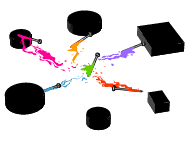Activity 1 : Appropriate for All Ages
|
Activity
2 Activity
3 What is National Science & Technology Week? Find out what find out why is all about.
|
Exploring
the Art of Science
How
could you use magnets to produce a work of art?
 |
Here's what you need for each child or team of children:
-
6 magnets (strong refrigerator magnets are fine)
- paper
and pencil or pen
- other
materials you and the children determine (see below)
To produce the artwork pictured on the front of this poster, George Whitesides writes, Felice Frankel used the physical and chemical properties of a ferrofluid and six magnets to create "shapes seen nowhere else in nature." The result, highly magnified, is a dramatic image that evokes wonder and begs explanation.
In this activity, participants (adults and children are intentionally included), working individually or in teams, will challenge themselves to do the same.
1. Begin with a discussion of the ways that art, science, technology, and engineering intersect with each other. You might ask everyone to write down examples of beautiful (or artistically powerful) things from the natural and manmade worlds: snowflakes, diamonds, the Eiffel Tower. Suggestions may come slowly at first, but should come quickly as everyone gets the idea. For each natural image suggested, ask if there is a manmade equivalent. For instance: is there as much "art" in a perfectly engineered, polished ball bearing as there is in a naturally matured pearl?
2. Display the poster. Ask participants to describe the image and suggest what it is. Write down all ideas. Then ask a participant to read aloud George Whitesides' narrative about the image on the poster. Ensure that everyone understands how this work of art was produced. Ask: why is the image so dynamic? Part of the reason lies in the processes used to create it. Frankel assembled the components, but then let their own natural properties do the rest.
3. Challenge participants to use magnets and other components of their choice to create their own work of "science-in-action" art. You might suggest that their first effort use the same pattern as that used by Felice Frankel, with a substance in the center that will be attracted to magnets arranged in a surrounding circle. (Use the graphic presented as part of Activity 3 as a guide.) Subsequent efforts can put the magnets and substances to different uses in different patterns—limited only by the imagination of your participants.
The stronger the magnets, the better your results will be. Experiment with placing the paper on top of or below the magnets. Try dropping several small items containing iron simultaneously or just one at a time, letting each item move towards the magnet nearest where it falls, trailing paint or food coloring behind it. Change the color of your food dye or paint, creating a mix of brightly colored "trails." Possible strategies and components include:
-
dipping small nails in poster paint and dropping them onto white paper in the center of a circle of magnets.
-
dipping paper clips in food coloring and dropping them onto wetted wax paper, again in the center of a circle of magnets.
-
placing several nails with different colored paints on paper and manipulating them with a magnet held underneath the paper.
Encourage participants to be as daring and creative as possible. If children want to experiment with small items that do not contain iron (and therefore won't be attracted to the magnets), let them; it's all part of the learning process. Persistence is the engine of good art, as well as good science.